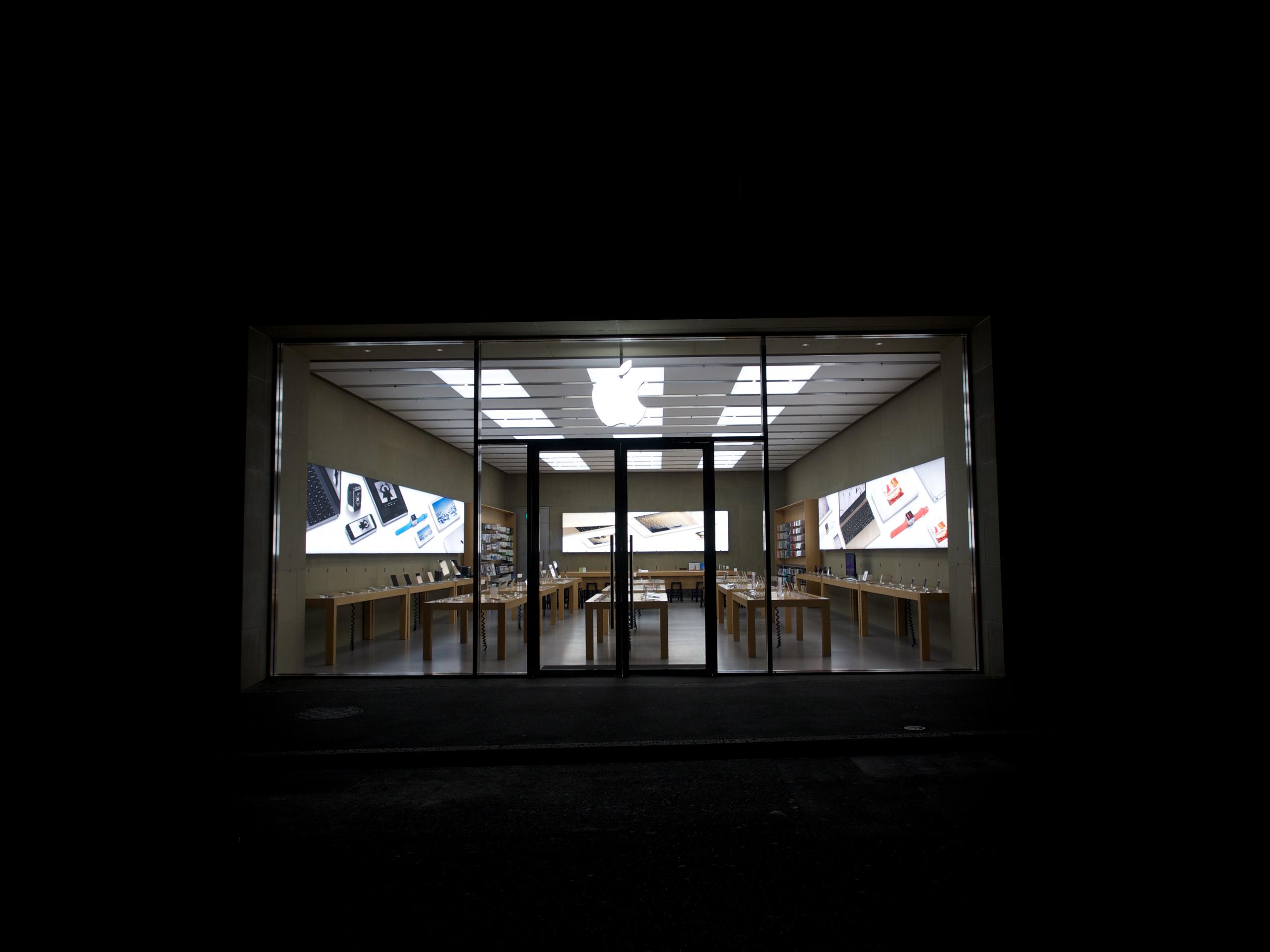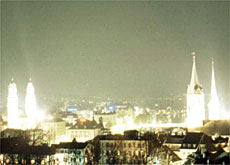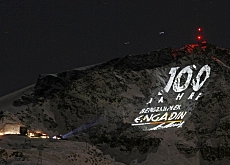Looking at the skies in a new light

Nowhere in Switzerland is completely dark at night any more. Increasing light pollution is not just a problem for astronomers, however. It has serious consequences for human health and entire ecosystems.
When an earthquake knocked out the power in Los Angeles in 1994, many anxious residents called local emergency centres to report seeing a strange “giant, silvery cloud” in the sky. What they were seeing – for the first time – was the Milky Way, long obliterated by a halo of light arching over the city. The situation is not so different in Switzerland.
“When I was a child [in the 1970s], I could look into the sky in town and see the galaxy of AndromedaExternal link. Today that’s impossible. The overall amount of light has increased so much that you wouldn’t see it in an average city or not far into the countryside,” Lukas Schuler, president of Dark-Sky Switzerland, told swissinfo.ch.
swissinfo.ch recently bumped into Schuler – it was dark – at the 27th Star Party, an international “telescope gathering” on the Gurnigel Pass in canton Bern, one of the darkest places in Switzerland.
Fifty or so professional astronomers and amateur star-gazers had travelled to the scenic 1,600-metre mountain restaurantExternal link during a new moon (paradoxically the moon is also a form of light pollution for astronomers). The plan was to listen to a couple of lectures on light pollution and then walk to the nearby “star platform” to enjoy the wonders of deep space.
Foreign light!
As it turned out, rainclouds meant not a single star was gazed. “It’s not my hobby but I accompany my husband and console him when the weather’s like this!” one woman told swissinfo.ch.
“We’ve come from Stuttgart in Germany, but you can’t get a really dark sky in Stuttgart – the sky is illuminated,” the disappointed husband, a keen astrophotographer, told swissinfo.ch. “Therefore I often travel to locations with a really, really dark sky: the Swiss mountains, the Canary Islands – the Mecca for amateur astronomers is Namibia. I’ve been there.”
So where’s the Namibia of Switzerland? “Maybe it’s here, the Gurnigel,” said Jörg Hummerjohann, president of the Astronomical Society of Bern.
“The Gornergrat [near Zermatt] is also very dark, but they have problems with the light coming from Milan, even above the very high mountains.”

More
Not everyone wants to see the light
Dwindle, dwindle, little star
Schuler explained that the skies above Swiss cities are around 500 times brighter than those above Swiss villages in the country. “In cities like Zurich, Basel, Geneva, Lausanne and so on we can see only a few dozen to a hundred stars. No more,” he said. In theory, given a typical dark sky, several thousand starsExternal link are visible.
“In the Alps the skies are still quite dark but not as it would be naturally without any artificial light. It also depends whether there is a ski area with illumination. But there is no area in Switzerland that is completely dark. Measurements and simulations show that there is no sky still in its natural state.”
What can I do?
Dark Sky International has various suggestionsExternal link how you can get involved in combating light pollution – from inspecting the lights around your house to becoming a ‘citizen scientist’.
And it’s all our fault. For hundreds of thousands of years, humans got by with fire. Then, with the invention of gas lamps at the end of the 18th century followed by various types of electric lamps, halogen lamps, LED lamps and so on, our roads and buildings – not to mention shop windows – have become increasingly illuminated. All through the night.
As a report by the US National Institute of Environmental Health SciencesExternal link (NIEHS) noted, “one of the defining characteristics of life in the modern world is the altered patterns of light and dark in the built environment made possible by use of electric power”.
“The main causes [of light pollution] are big cities with a lot of installations like street lights, advertisements, sport stadiums and monuments with dramatic lighting. There’s a lot of light that doesn’t shine only on the streets or the monuments but goes directly into the sky,” Schuler said.
“And nobody notices – we only see the effect on the walls. We don’t easily see the light that goes beyond, into nature.”
Carcinogenic consequences
Dark-Sky might sound like a Philip Pullman novel but it is in fact an international NGO which works “to preserve and protect the night-time environment and our heritage of dark skies through quality outdoor lighting”.
“The main consequences of light pollution is that it disturbs living organisms – plants and animals,” Schuler said.
“Humans have to recover during the night, so we produce hormones that help us do that, but they are only produced if you are in the dark. If not – and not much light is needed to disturb this process – we don’t produce the hormones so we don’t sleep well. If that happens night after night, we basically become unhealthy.”

More
The dark side of light
The NIEHS report concluded that “it may not be entirely coincidental that dramatic increases in the risk of breast and prostate cancers, obesity and early-onset diabetes have mirrored the dramatic changes in the amount and pattern of artificial light generated during the night and day in modern societies over recent decades”.
Damaged ecosystems
But it’s not just humans who are affected by intrusive light from streetlamps, construction sites or advertising hoardings. Ecological light pollution can result in dramatic changes in ecosystems.
Almost all small rodents and carnivores, 80% of marsupials and 20% of primates are nocturnal. Birds and moths and other nocturnal insects can get confused by lights and their navigation is disrupted. Worse, they are drawn to lamps and are then burnt to death. This in turn affects night-blooming plants which depend on them for pollination. Plants also grow too quickly and notice too late that it’s autumn – or even winter – and then freeze.
Jörg Hummerjohann said that when he was a child, fireflies were everywhere. “They have more or less disappeared and this is because of light pollution – males and females can’t find each other because there’s too much light,” he said.
Frogs have also been found to inhibit their mating calls when they are exposed to excessive light at night, reducing their reproductive capacity. The feeding behaviour of bats is altered by artificial light.
Rolf Schatz, a biologist and director of Dark-Sky Switzerland, gave a personal example of the effect of light pollution on the ecosystem.
“I’ve recently finished an eight-year research project in canton Zurich, looking in 1,100 rivers and streams for crayfish. I was filming with Swiss television and when we wanted to film the crayfish at 9.30pm, they were no longer there. I wondered why – because I knew there were loads there – and I realised the film lights had been on for about an hour,” he said.

Lights out!
“Apple was a really bad example – it was the brightest shop I’ve ever seen and it’s bright 24 hours a day,” said Barbara Spielmann, a board member of Pro Obscurare, a lobby group whose latest campaign, Licht Aus (Light Out), aims to get shops to turn off their lights between midnight and 6am.
“This is a time when no one is in the city and the light has no purpose. Shops must pay for the energy but get no money back,” she told swissinfo.ch at the Star Party.
“We simply can’t afford to have such a wasteful attitude towards energy, because there is a finite supply. Where it’s not needed, we shouldn’t waste it.”
“About 150 shops have joined usExternal link. That’s OK but it could be more. But they have other problems: the cheap euro for example. In the priority list, turning the lights off is number 100. A lot of shop owners say it’s a good thing but getting them to do something is not easy.”
Apple Switzerland did not respond to swissinfo.ch’s requests for a comment.
Spielmann said it was easier to convince the public than shop-owners. “Customers generally like it when the lights are switched off. It’s like with children and their bedroom light – you have to turn off shop lights at night too.”
The law
Whereas campaigners see light pollution as a form of environmental pollution like noise, air or water pollution, the law generally doesn’t.
Norm SIA 491, which came into effect on March 1, 2013, says that “disturbing” light sources that do not have a security purpose (i.e. they are used for decoration or advertising) must be turned off between 10pm and 6am. Christmas decorations are an exception, which may be on until 1am from the beginning of Advent (in 2015, November 29) until January 6.
The catch, however, is that an individual can only demand these lights be turned off between 10pm and 6am if he or she lives within 100 metres of them. So a large industrial site could be disturbing for wildlife and astronomers, but because no one lives within 100 metres, no one can lodge a complaint.
Compared with other forms of environmental pollution, the solution is very simple: turn off lights.

In compliance with the JTI standards
More: SWI swissinfo.ch certified by the Journalism Trust Initiative














You can find an overview of ongoing debates with our journalists here . Please join us!
If you want to start a conversation about a topic raised in this article or want to report factual errors, email us at english@swissinfo.ch.